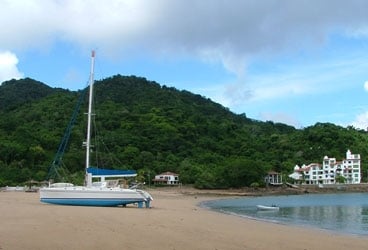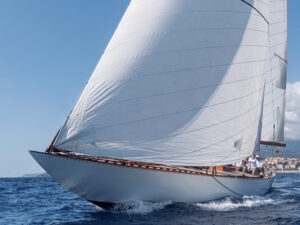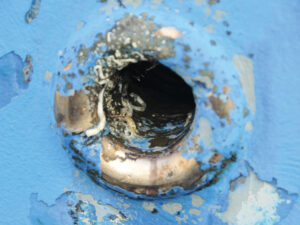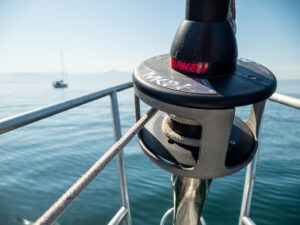
Beached
Ashore, my driving skills supplied endless material for family jokes, and since some things never change, my skills at the helm now fit that bill. So, I knew the family grapevine would blaze like an out of control wildfire when pictures hit their computer screens of our 53-foot Catana catamaran, Esprit de Tizza, parked in the sand at a resort in Panama.
We had set sail from the Panama Canal, eight degrees north of the equator, during rainy season. Cumulus clouds morphed into a tumultuous squall and belched a thundering roar. Lightning pierced the sky and sparred with our mast as we navigated around anchored ships waiting their turn to transit the Panama Canal. Logs, washing down the rivers into the ocean, reared up like cowboys on bucking bulls and rode the water’s foaming fury around us. At the helm, my husband cautiously maneuvered through the stationary and mobile monoliths. I nervously dashed about the cockpit in my reflective foul weather gear. Glowing in the electrical storm charges like a neon rubber duck, I attempted to sight the debris before an encounter brought our ride to a complete stop.
Fortunately, the squall passed quickly and the sun peeked out, highlighting freshly washed rainforest greens on the island of Contadora, 38 nautical miles south of Panama’s Balboa Yacht Club. Contadora, a frequent venue for Central American political meetings and a vacation spot for wealthy Panamanians, appeared inviting. But we sailed on to less developed islands further south in the Las Perlas archipelago, lured by the stories we’d read of their beauty.
The islands of Morro de Cacique and Isla del Rey provided hours of kayaking and exploring between peacefully dreamy catnaps in the cockpit hammock. On our approach to the Don Bernardo anchorage at Isla Pedro Gonzalez, the sun dissolved into the sea and ended another delightful day. We were tucked in tight beside the tiny islet on the east coast of the island and noticed a white cross crowning its peak. It was illuminated in the colorful burst of sunset. Hand-cut stone stairs, carved steeply through thick vegetation led to the cross that ignited our imaginations but suggested sacredness.
Dawn the next day accentuated the island’s practical beauty. Two dwellings, hidden at dusk, were visible now. Fishermen sat visiting and preparing their boat for departure. We sat admiring the velvet beach and commenting on the magnitude of the 18-foot tidal range-optimal conditions for careening.
My husband is an experienced sailor with a sense of humor and an uncanny ability to play my gullibility. So when he suggested driving the boat up on the beach, it sounded more like a conversation I would start with, “Honey, there’s something I need to tell you…”
Though anxious to take advantage of this rare opportunity to careen, we thought it more appropriate and courteous to receive permission first. Going ashore with our two children, we approached an isolated dwelling at the far end of the beach. In front of the home, flat rocks had been placed strategically to create a functional and aesthetically pleasing knee-high sea wall with stairs. Beyond the wall, the yard was sculpted from the rainforest flora and swept spotlessly clean with a palm frond broom. The thatched-roof home, built on stilts above the high water line, had framed openings in the front and rear to provide ventilation. Dots of color bloomed from hanging plants inside while a hand carved sign at the door reflected pride and warmth. Chickens roamed freely in the yard and clucked with mild interest at our presence.
A slight-framed man with gray hair and wise eyes emerged from the house with the aura of a native chief. Beside him his protective dog, the size of a peanut shell, tried out a territorial bark quite contrary to his wildly wagging tail that begged the kids to play. With motions and our best gringo Spanish, we requested permission to beach our boat and received his consent.
Our preparations started with combing the beach at low tide for the most even-sloping spot free of rocks and debris. Identifying a clear area, we visually noted a log on the beach as a reference point. Then using our kayak, we traced our approach in the clear water to search for any underwater obstacles we would need to avoid or clear with our four-and-a-half-foot draft when coming ashore. There were none.
RELATED: Tips for Transiting the Panama Canal
The plans in order, we turned our attention to the inspiring serenity of the island. We indulged in a deliciously fresh tropical meal and a siesta before entertaining the kids with more swimming, snorkeling, and kayaking. It was early to bed and early to rise as the following morning’s high tide was at 6:30.
With an invigorating breath of morning air and some strong Panamanian coffee, we raised our anchor and eased toward the driftwood that marked landing spot. As we approached, we noticed a side current not evident at yesterday’s low tide, so we dropped our stern anchor to prevent us from swinging. My husband reminded me it was imperative to rest the hulls perpendicular to the water’s edge to achieve even weight distribution. Otherwise, the boat could suffer structural damage. We inched forward intermittently snubbing the stern anchor rode to keep our boat straight.
Next we needed to set our bow anchor to hold the bow to the beach until the ebbing tide rested our hulls in the sand. I had dropped our hook hundreds, probably thousands of times. Under normal circumstances, we just drop it, then back down to set it. But now we’d have to drop the anchor and then hand set it slightly farther forward to secure the boat. As this was my first attempt at careening, I was anxious to impress my husband with my aptitude.
As we crept forward, I let go the anchor rode dropped the bow anchor. Circulating strong coffee through my system instead of brain stimulating oxygen, I leaped over the bow fully clothed and prepared to manually nudge our 75-pound spade anchor the necessary few feet. Unfortunately, the clear water was deceptive and well over my head. I clung to the chain smiling, giving the thumbs up, and pretended to be making progress. John, though, suggested I come back on board and try again. We advanced into shallower water.
After a short game of tug of war with the anchor lines, we secured taut bow and stern lines in water that was deep enough to ensure we wouldn’t become a permanent landmark. We lowered the dinghy from the davits while still afloat to reduce unnecessary weight on the hulls and to provide a source of play for the kids so they could paddle about at the end of our tethered painter. John shut down seawater dependent boat systems, then dropped the swim ladder for getting on and off board while beached. As the water began to recede, Tizza nested her hulls in the sand for her afternoon mechanical examination and cleaning.
With the exception of changing zincs, disassembling or repairing either of our three-blade folding propellers must be done out of the water, and we expected they’d need some attention. Due to a line handler getting his line caught in our port propeller during our Atlantic-to-Pacific transit of the canal, we had hauled out recently in Panama City to check for damage and to apply new bottom paint. When back in the slings, the travel lift bumped another boat as it approached the launch and sent Tizza swinging. We had not been lifted properly and our forestay slammed into the crossbeam of the travel lift. The result was grease our new head sail and cosmetic damage to our hull. Back in the water, we sensed a slight vibration that suggested the possibility of damage to the propeller once again. It was an easy decision not to haul out at that yard again for an inspection.
As the water ebbed, John began washing the waterline and taking care of routine maintenance as he waited for the propellers and zincs to become exposed.
Meanwhile, when the kids tired of their imaginary adventure in the tethered dinghy, I took them to explore tide pools and go for a swim. The chief appeared with his dog and spoke emphatically. I was able to interpret danger as he suggested the kids should not swim in our chosen spot. Grateful for his local knowledge and warning, I started packing up our things so we could go the area he deemed safe. As I was packing, he nodded toward our French-made and named boat and inquired flawlessly, “Parlez-vous francais?”
My Spanish has progressed to mildly amusing, but my French is still strictly limited to a travel phrase book. I replied in Spanish, no. He asked me if we liked mangoes but walked away before I finished my lengthy reply of yes.
I was a little puzzled, but quickly turned my full attention back to our children splashing wildly in the water again. Moments later, the chief placed two overflowing bags of mangoes in the middle of the beach then walked away without a word. Being the only other people within miles, there was little doubt the mangoes were meant for us.
I collected the freshly picked mangoes and returned to the boat to refill his bags with items I thought he might appreciate: pasta and sauce, bread and preserves, homemade chocolate chip cookies, and a cold beer. The kids and I walked them to his house and called from the stairs of the seawall. There was no answer, though we knew he was there, so my daughter set the bags on the stairs out of the chickens’ reach.
Back at the boat, John had completed the work list successfully and the slack tide was beginning to flow. As we prepared to leave, the chief returned with another two bags of mangoes and a smile. We thanked him and said goodbye. It was a mystifying but memorable exchange that I hoped was a simple demonstration of mutual respect.
We shackled our tender back to the davits but left it floating to keep weight off the hulls. When we were fully afloat, we first raised our bow anchor and then hoisted up the dinghy. Smooth as Tupelo honey. Moments later however, marriage vows were tested as I attempted to raise the stern anchor without getting yet another line caught in the propeller.
When my mission was accomplished, I admitted I wasn’t ready to write the textbook on beaching a cat, but I proudly added a new notch to my sailing belt.
A few months later, happenstance found us on the beach again. Cruising friends had invited us to sail to Taboga, eight miles south of the Balboa Yacht Club. Known as the Island of Flowers, Taboga tastefully blends natural and manicured beauty to create a charming retreat from the hustle and bustle of Panama City. Among its attractions are the ruins of the sanatorium that housed French canal builders plagued with malaria and yellow fever. One noted patient was French Impressionist, Paul Gauguin, who once worked as a laborer on the canal. Colorful tributes to Gauguin grace the sanatorium’s entrance while a short hike up the road from the sanatorium leads to breath-taking ocean views. Taboga also has a soft, sandy isthmus that’s exposed at low tide. Once again, we were presented with the opportunity to careen for routine maintenance.
This time, conditions allowed us to simply set our stern anchor then motor forward until our bows rested in the sand. It was an easy on and easy off this beach. I surmised careening is like so many other things in sailing…you can strive to perfect technique, but Mother Nature often dictates the outcome. She granted us pristine conditions in Taboga, and a picture worth a thousand laughs amongst our family.
Claudia Lee-Ottman and her family are in New Zealand, where, they report, they’re continuing their cruising and having fun.








